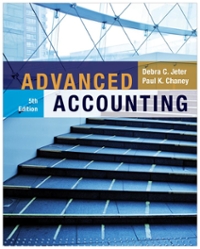Question
1.When an investment in a debt security measured at amortized cost is transferred to held for trading security, the carrying amount assigned to the held
1.When an investment in a debt security measured at amortized cost is transferred to held for trading security, the carrying amount assigned to the held for trading security should be
a.its original cost.
b.its fair value at the date of the transfer.
c.
the lower of its original cost or its fair value at the date of the transfer.
d.the higher of its original cost or its fair value at the date of the transfer.
2.When an investment in equity securities irrevocably elected on initial recognition to be subsequently measured at FVOCI is transferred to held for trading because the company anticipates selling the stock in the near future, the carrying amount assigned to the investment upon entering it in the trading portfolio should be
a.its original cost.
b.
its fair value at the date of the transfer.
c.the higher of its original cost or its fair value at the date of the transfer.
d.None of these
3.According to PFRS 9 Financial Instruments, investments in debt securities classified under the amortized cost measurement category should be recorded on the date of acquisition at
a.lower of cost or market.
b.
market value.
c.fair value plus brokerage fees and other costs incident to the purchase.
d.face value.
4.
Which of the following is correct about the effective interest method of amortization?
a.The effective interest method applied to investments in debt securities is different from that applied to bonds payable.
b.The amortization of a discount decreases from period to period.
c.The amortization of a premium decreases from period to period.
d.The effective interest method produces a constant rate of return on the book value (carrying amount) of the investment from period to period.
5.A debt security is purchased at a discount. The entity wants to classify the investment as a financial asset measured at FVOCI. The entry to record the amortization of the discount includes a
a.debit to investment account.
b.debit to the discount account.
c.
debit to Interest Revenue.
d.none of these.
6.On December 29, 20x1, an entity commits itself to purchase a financial asset for 10,000, which is its fair value on commitment date (trade date). Transaction costs are immaterial. On December 31, 20x1 and on January 4, 20x2 (settlement date) the fair values of the asset are
12,000 and 15,000, respectively. If the entity uses the settlement date accounting and that the investment is classified as held for trading, how much is the carrying amount of the investment in the December 31, 20x1 statement of financial position?
a. 10,000c. 15,000
b. 12,000d. 0
7.
On January 1, 20x1, Dagul Co. acquired 10%, 4,000,000 bonds for 3,807,853. The principal is due on January 1, 20x4 but interest is due annually starting December 31, 20x1. The yield rate on the bonds is 12%. On July, 1 20x1, Dagul Co. changed its business model. It was ascertained that the investment in bonds at amortized cost should be reclassified to held for trading securities on reclassification date. The bonds were quoted at 102, 103 and 104 on July 1, 20x1, December 31, 20x1 and January 1, 20x2, respectively. How much is the gain (loss) on reclassification on January 1, 20x2?
a. 243,676c. 295,205
b. 255,205d. 0
8.
On March 31, 20x1, Budoy Co. received 10,000 stock rights from its investment in equity securities to subscribe to new shares at 60 per share for every 4 rights held. Prior to issuance of stock rights, the shares were selling at 80 per share. How much is the initial carrying amount of the stock rights?
a. 20,000c. 50,000
b. 40,000d. cannot be determined
Step by Step Solution
There are 3 Steps involved in it
Step: 1

Get Instant Access to Expert-Tailored Solutions
See step-by-step solutions with expert insights and AI powered tools for academic success
Step: 2

Step: 3

Ace Your Homework with AI
Get the answers you need in no time with our AI-driven, step-by-step assistance
Get Started


